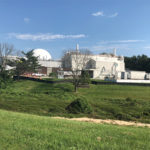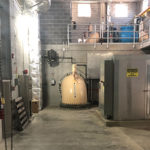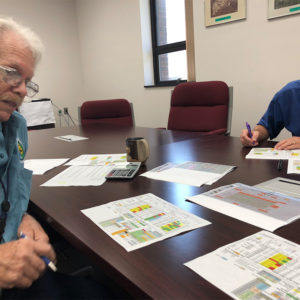In case you were wondering, people named Robert are–right off the bat, because of our names–the best. Some, like Robert Hindt, the Administrative Manager at the Little Patuxent Water Reclamation Plant, have a highly-advanced skill set, a winning managerial style, and a generous spirit to boot. I visited him (heretofore known as Hindt) and his staff at the plant to get an idea of how our water goes from looking like what one of his coworkers described as chocolate milk to some of the cleanest in the nation.
One of the main reasons we need a robust sanitation system in a populous place like Howard County is all the ickiness, shall we say, in wastewater. The following statistic will make you think–and maybe wretch! “A gram of feces contains 10 million viruses, 1 million bacteria, 1,000 parasite cysts, and 100 worm eggs,” wrote author Rose George in The Big Necessity. It’s a survey for lay readers of the many ways humans have and do clean the water their communities use.
At the plant, I learned a couple of memorable phrases that day. One was, “Most people are ‘flush and forget,'” said Bill Holland, Engineering Support Supervisor at the plant, who was also the one who compared untreated wastewater to chocolate milk, which I loved. He’s another highly skilled and personable employee at the plant. Bill is not only uber-knowledgable about his work, but he has a knack for imparting his passion for it to others. Before Hindt gave me a tour of the plant, I sat in on a process control meeting that Hindt and Bill had. There was a third entity–well, many more–in the meeting, actually: the microorganisms in the water. Bill has an intimate understanding of them, a combination of a respect for their role in water treatment and an adeptness at finessing them so they behave in a way that’s in the best interest of getting clean water to county residents.

“The microorganisms are like children: when you pay attention to one, the others tend to get mad,” Bill told me. He said that they don’t have cell phones or TVs, an image that made me laugh, so they only do two things: eat and procreate. Their food, Bill pointed out, “is all the disgusting stuff we put in the water.” So, in a way, Bill is a chef. He said that what I find to be a disturbingly cavalier attitude adopted by most of the world (my words) about how we treat our water changed a few years back when our collective mindset about environmental issues became more sensitive. One such example, he told me, was the Chesapeake Land and Water Initiative.
“The Land Trust Alliance recently launched the Chesapeake Bay Land and Water Initiative (the Initiative) to deploy an integrated and innovative approach to permanent land protection, stewardship, community engagement, partners, and public policy that will preserve or enhance water quality across the 64,000-square-mile Chesapeake Bay Watershed,” says its website. And as I learned, the fact that we in HoCo are surrounded by such a fragile ecosystem of eau, populated by such advanced people, and founded on such sanguine principles of development, is why we have such clean, clear, and frankly, tasty water.
Back at the meeting, Bill and Hindt switched easily and rapidly from a familiar, colloquial rapport with me to a technical, expert but still friendly one with each other. It was like hearing people speak two languages, moving from standard English to the argot of a sociological sub-group. Both Bill and Hindt were so mindful of my desire to learn all I could about their work, I was getting ready to tell them to ignore me and get to work. Just when I was about to, they’d move back to talking shop, though. There was a relaxed, fun feel to the meeting. Both Hindt and Bill were dressed semi-casually. Hindt removed his glasses, rubbed his eyes, and pushed aside a lock of his greyish blond hair as I thought how their capacity for switching from task to task, therefore, made my presence in their meeting less disruptive than it might have been for people not as good at what they do.
During my mini-lesson from Bill on wastewater treatment, like a true educator, he asked me a guiding question: “What big event happened the last couple days?” he said in his gravely but friendly voice. I was stumped, at first. After a few seconds of thought, I blurted out: “The rain!” Bill nodded his approval. It led me right up to my next question.
“Isn’t one way to deal with polluted water just to add more unpolluted water to it? Isn’t it good for the plant here when it rains a lot?” I asked, like the the wastewater treatment neophyte I was. Hindt smiled and said gently, “We like to say, ‘Dilution is not the solution to pollution.'” Another great little saying to remember about wastewater treatment, like “Flush and Forget.” Hindt directed me to the website for the Water Environment Foundation, and it notes, in this vein, “Somewhere. Every drop of water we use goes somewhere.” Menacingly put, but effective!
When Hindt and Bill were done commiserating on what to do, if anything, about the various chemical metrics in the daily report, it was time for Hindt to show me around the plant. I got to don a hard hat and a reflective, fluorescent orange and yellow vest, always a fun thing to do, and so did Bill. I’ll be honest with you, readers. When I pulled my car up to the plant, it was the first time it dawned on me that it might not smell the best. When I got out of my car, I was surprised at how it really didn’t smell that unpleasant! In fact, the general odor at the plant was kind of…nice! It has a rich, organic bouquet, as opposed to a noxious, chemical one. So there’s something familiar and almost appealing about it. At times over the next two hours, the general fragrance changed from meaty and thick to similar to the elephant exhibit at a zoo to oceanic and breezy to, finally, simply too much. By the end of my tour, the intensity of the aromas was lodged in my nasal passages, and it felt like it was making me a tad dizzy.
Hindt has a slim build that seemed almost made for trekking about the plant in big strides, as if his decades of work in the field of wastewater treatment, not to mention his degree in chemical engineering, have adapted him to the work. It’s easy to see he cherishes his work, and the same was true of Bill and all the other employees I met that day, such as lab dwellers Justin Myers, Plant Superintendent, and Sonya Williams, Laboratory Manager. Even the non-permanent construction workers upgrading parts of the system seemed happy and to love what they were doing.
The lab was the first place Hindt showed me. It reminded me of my sister’s, an M.D. who researches cancer, with its beakers, bags of unidentified fluid, and tools you’d never see anywhere else so have no idea what they are. You also feel like you shouldn’t ask because the answer might gross you out.
The next was the control room, which resembled one you’d see on an episode of Star Trek, complete with flashing lights, a backward sloping interface with all sorts of buttons and knobs, complicated-looking keypads, and elaborate charts. It added to the plant’s resemblance of what I’d imagine a nuclear power plant looks like, both inside and out. I thought of a stanza from the lyrics of “Part of Your World,” one of the songs penned by Alan Mencken and Howard Ashman for Disney’s The Little Mermaid: “I’ve got gadgets and gizmos aplenty./I’ve got whozits and whatsits galore./You want thingamabobs?/I’ve got twenty…”

And: I chatted with Regina Clay, a local activist and spiritual leader, a few weeks back.
“Are you ready to do some walking?” Bill asked me jovially with a winsome grin. I confirmed that I was. We proceeded, Hindt and I, then, begin to weave our way about the plant for a total of about a mile, like the stalks of algae that snaked through some of the tanks we were to see. We ducked in and out of buildings on the grounds, which had a boiler room feel, what with their dim lighting, ubiquitous pipes, and echoing sounds of machinery at work. Alternating with those places, we strolled about the open air tanks and vats all over the grounds where human-made machines, those infamous microorganisms, and the plants’ employees were hard at work turning “chocolate milk” into sparkling-clear water.
The sound of water cascading down inside tanks that looked filled to the brim and then out of them to other areas surrounded us, but we also passed by bubbling, roiling water that emitted the same sounds boiling water does. This is where, after all, an elaborate series of pipes and drainage systems from around the county bring tens of millions of gallons of water to be treated every day. When most of us are flushing and forgetting, the Little Patuxent crew, from the managers to lab workers to various engineers–and don’t forget those temperamental divas, the microorganisms–are hard at work. In fact, the plant needs to be staffed all day and night around the year.
Hindt showed me the thirteen tanks that treat the massive amount of water that passes through the plant every day, 20 million gallons on averge. The first vats take out solids, big chunks of material. The next ones we visited were where the microorganisms, those Belles of the Wastewater Ball, performed their vital work of breaking down the pollutants in the water. Hindt stopped at a couple for me to get a closer look at what was going on inside them. It never got old, I tell you!
Along the way, Hindt had a smile and cheerful greeting for everyone we passed on our walk. He’d stressed to me in an email that he wanted this article really to be more about the excellent group of hard-working, talented employees he manages. I thought, “This is the kind of humble, supportive boss everyone wants.”
“Different people at the plant see things differently,” Hindt had said to me inside when were chatting about the general work of his staff. Clearly, the group has found a way to manage all the roles its employees play to get us HoCo-ers pretty much the best product we could ask for. I’m not exaggerating when I say the last tank of water we passed had such clear water rushing out of it, it almost made me thirsty.
As we made stops along the tour, one of the many sights I’ll never forget was an enormous pipe that manages some of the water that moves into and about the plant. It looked like a bloated, beige worm ducking into one of the indoor areas we came to. Another was a giant rake moving lazily through one of the sedimentation tanks Hindt showed me. The most surprisingly colorful things we saw were bright green dots peppering the brown water in one of the tanks I peered into. Hindt told me this was algae.

“I like to say, if people aren’t aware of us, we’re doing our job right,” Hindt said as we continued our sojourn. The Plant folks seemed not to mind that while we generally give, say, firefighters or police officers their due respect, most of us rarely think of the people doing the vital work of wastewater treatment. Hindt and the others at the plant are non-plussed by this. They love their work, very obviously, and it seems like that’s enough for them.
After California’s and Arizona’s, Howard County’s water, Hindt told me, is the most pristine you’ll find anywhere in the world, as mentioned above. Both Hindt and Bill stressed that this salutary fact is thanks to the pro-Chesapeake legislation and initiatives that require us to care for this life-giving liquid. Bill, especially, made a point to emphasize how clean water standards–the kind of regulations the current federal administration seems not to be too fond of, if you ask me–keep our aqua so sparkling.
Hindt and Bill both underscored that, as populations grow, the need for them to actively address water sanitation is key for them to thrive. This seems like another reason that stormwater management is so important in Howard County, nowhere more than Ellicott City, given its topography, history, and a booming population.
“Stormwater discharges naturally to lakes, rivers, and streams,” said Dylan Drudul, a local expert in stormwater management. He said Howard County has separate wastewater and stormwater management systems. Baltimore County, by contrast, does not. I would guess the separation of the systems here in Howard is necessary because of, but also grounded in, the thought and care that goes into decisions about the area’s infrastructure.
Both Hindt and Bill confirmed my amateur’s suspicion that water, like energy, isn’t really created or destroyed. Energy, says the first law of thermodynamics, only changes form. Water, I’d say after my Little Patuxent Plant visit, simply…well, changes. It doesn’t appear and disappear, in other words. The water we have is here to stay, so it’s a good thing–a very lucky thing–for HoCo that it has people as passionate, proficient, and delighted by what they do care for ours.
“Two words: public health,” Tim Lattimer, International Advisor at the U.S. Water Partnership and member of the Howard County Democratic Central Committee answered when I asked him why clean water is so important to the proper–and high–functioning of a society. “Unsafe water kills more people each year than war and all other forms of violence combined. Lattimer pointed out that 6,000 kids–the equivalent of two 9/11s every day–die from waterborne illnesses around the world. Children, he said, underscoring the importance of this work to a population that we care so much about in HoCo, are the first to get sick and die from waterborne illnesses. He said the best thing we could do for public health and economic development around the world would be to invest in clean water and sanitation.
I flashed back to a trip I took to Nepal during a summer break from college. I was an avid mountain-climber and wanted to ascend some of the peaks in the Himalayas. I saw what a lack of sanitation looks like. Food, excrement, and other pollutants ran down streets and around the villages. Children played blithely just inches from stuff we’d never allow them near knowingly. Of course, we can only control the behavior of others so much. So perhaps the first and most effective step, which Hindt confirmed, is to be conscious of what we put into the water in the first place. To that effect, the plant has programs to help people dispose of prescription drugs, which find their ways into our water at alarming rates. That’s just another way that the staff at the plant is doing us all a great service here in HoCo, as Ned Tillman, a partner at a local business, Sustainable Growth, and author of three books on environmental stewardship told me. His latest book on the topic, The Big Melt, is due out this fall. It’s aimed at young adults, but Tillman has a way of communicating that would make adults as excited to read it as kids, no doubt. It’s about climate change, and some say nothing should be expressed in a manner more complicated than one that a child couldn’t understand it.
Also: This is what transpired at this year’s Maple Lawn Festival this summer.
“Clean water is so important to the high living standards we have here in HoCo,” said Jen Terrasa when Colleen and I saw her at a political fundraiser recently. She’s a progressive candidate for State Delegate in Maryland’s District 13 who’s currently on the County Council. She was in fact, the one who introduced me to Hindt, my new water-reclamation-based best friend. My visit to the Little Patuxent Water Treatment Plant brought this fact home to me, someone who already thought about a good bit about it. It also made me see that our water’s being skillfully and carefully stewarded here in HoCo.
The last thing Hindt did after a lovely two hours and before we parted ways (for now) was to shake my hand, look me straight on, smile, and say: “Wash your hands.” I’ll drink–clean water–to that!
A Word on Wasting Water
Before I got up to leave, I put my note-taking pen and paper on the conference table in front of me and Robert. I closed my eyes, leaned back in my bendy office chair, and let out a deep breath. Since I was a young child in Queens, I’ve been obsessing about “wasting water.” I wanted to ask Robert if that’s possible, given that water moves through the water cycle over and over, he and his gang treat our water in HoCo so well, and water, I’d been thinking, is like energy, and can neither be created or destroyed (or so I thought).
“In a general sense, water is neither destroyed nor nor created–much like energy–that is not 100 percentscientifically accurate because you can split water apart into hydrogen and oxygen atoms, but that takes a lot of energy and on earth is a deliberate act,” Robert said, addressing my last opine first.
He told me we have the same amount of water on Earth as we had a million years ago. Its forms (vapor, liquid, or solid) changes. The amounts of fresh and saltwater also change.
“However, water can be ‘wasted’ to a certain extent. The potable water that is delivered to your home is drawn from a lake, river, reservoir or aquafer–a well–and then cleaned and sent on its way to your house,” he said, nodding.
Wasting occurs when you let this water just run without using it for something.
“It then goes into the sewer to us, where we spend resources–energy, chemicals, and more–to clean it again, bringing it back to environmental standards, but not drinking standards,” Hindt went on.
After water’s released back into the environment, for us to get potable water again, it needs to go through the same process.
“The wasting is really in the use of energy and chemicals at least twice before it can go back to your house to use again,” he said.
This doesn’t, however, he added with a smile, as he could tell this topic stresses me to no end, I’m sure, as I felt my brow furrow account for all the things that can happen to water in the environment–both good things and bad things.
“The real issue is not water but “clean” water, which is what most of the developing countries in the world struggle with,” he said, “…I hope that helped.”
I said it did very much!
Thanks for reading! Check back with us here at rocoinhoco.com every week as Robert, Colleen (and pup, Moses) get to know the many facets—one each week–of this prismatic place called Howard County. We want to take you along with us, so follow us on Twitter at @rocoinhoco, join our Facebook group, and follow us on Instagram at @rocoinhoco.
